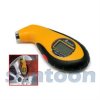Hi All,
Does anyone know how to get the pressure data from one of these cheap tyre pressure sensors?

The sensor is a bare silicon die on the PCB inside the device. There's a number of test points on the PCB, and the only one that appears to be useful is one that has pulses that alternate in amplitude. There are other TPs that have a stream of small pulses. All pulses on different TPs are in sync.

I captured the level of the pulses and coded them as '1' for a large pulse and '0' for a small pulse.
I further coded this so that "01" becomes '0' and "11" becomes '1' in the hope that this turned up some sensible information.
The above is recorded over 25 seconds; when the device is started, there is no pressure applied to the sensor (which causes the string of "01010101"s). Then a pressure of 15-30 psi is applied, and may be removed before the end of the recording.
I was too dumb to get any meaningful info from the data (which I assume has pressure information in it).
Anyone else up for the challenge?
Does anyone know how to get the pressure data from one of these cheap tyre pressure sensors?

The sensor is a bare silicon die on the PCB inside the device. There's a number of test points on the PCB, and the only one that appears to be useful is one that has pulses that alternate in amplitude. There are other TPs that have a stream of small pulses. All pulses on different TPs are in sync.
I captured the level of the pulses and coded them as '1' for a large pulse and '0' for a small pulse.
Code:
0101010101010101010101010101010101011101011101010101011101011101010111011111010101111111011111010101111101011111111111111111111111111111111111111111111111111111111111111111111111111111111111111111111111111111111111111111111111111111111111111111111111111111111111111111111111111111111111111111111101110111111101010111011111011101011111011111111111111111111101010101011101010101010101010101010101010101010101010101010101010101010101010
Code:
000000000000000000100100000100100010110001110110001100111111111111111111111111111111111111111111111111111111111111111111111111111111111111111111111101011100010110100110111111111100000100000000000000000000000000000000#I was too dumb to get any meaningful info from the data (which I assume has pressure information in it).
Anyone else up for the challenge?







